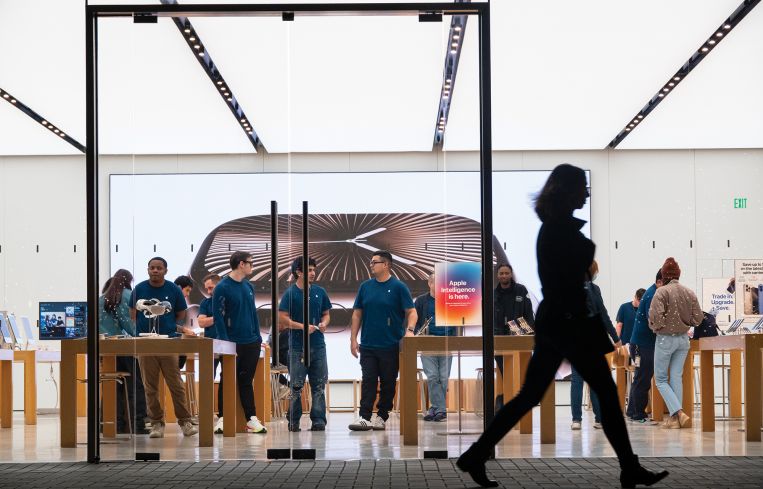Retail Looks for Bright Spots in the Possibility of a Tariff-Fueled Recession
The sector has only recently seen off other existential threats such as e-commerce and pandemic lockdowns
By Larry Getlen May 20, 2025 11:00 am
reprints
In April, Apollo Global Management’s chief economist predicted that the U.S. was headed toward a recession this summer.
This occurred before the May 12 announcement of a deal between the U.S. and China that would temporarily reduce tariff rates to a heretofore dizzying 30 percent, rather than the frightening 145 percent originally proposed.
But economic uncertainty was looming over the retail landscape even before President Trump’s “Liberation Day” tariffs announcement on April 2. (Interviews quoted in this article took place before the May 12 announcement, except where noted.)
Cushman & Wakefield reported that in the first quarter of 2025, demand for retail space nationally saw its weakest quarter since the onset of the pandemic, with net absorption dropping by almost 6 million square feet.
And there has been no shortage of news about retail closings and bankruptcies.
Big Lots, the country’s fourth-largest home goods retailer, declared bankruptcy in September. Party City did the same in December, apparel retailer Forever 21 did so in March, and pharmacy chain Rite Aid declared its bankruptcy in early May. Fast-food chain Jack in the Box, meanwhile, announced in April the closing of between 150 and 200 outposts.
Still, with so much uncertainty in so many areas and key factors changing by the day, a recession around the corner is far from a given, leaving some to emphasize flexibility in planning for the future.
“The first thing I would tell our shareholders or investors is to be prepared for a wide range of outcomes, because even though consumer sentiment is negative, consumer spending to date has remained surprisingly resilient,” said Ken Bernstein, president and CEO at Acadia Realty Trust, a real estate investment trust focused on open-air retail. “Even though the forecast for job losses is concerning, the current job numbers are pretty solid. So the thing to understand is that the environment we’re in today is much more resilient than the forecasts are predicting, but the forecasts could very much be correct.”
Soozan Baxter, from the retail consultancy Soozan Baxter Consulting, makes the point that savvy retail landlords shouldn’t be too thrown by the current economic uncertainty because their normal operations should already include a series of precautions and ongoing analyses regarding their tenants.
“Smart owners are always thinking about what’s happening 18 to 36 months ahead, and they always have a list of tenants that could be in trouble, which you define by looking at who pays their rent on time and how sales per square foot is going for those tenants,” Baxter said. “Smart landlords are always managing their fleet, and they know the brands that are at risk.”
Considering the oversize tariffs placed on, and by, China, Bernstein notes that part of smart retail management now is understanding the nature of a potential retail tenant’s supply chain.
“We are, as landlords and investors, spending time making sure we understand supply chains for our retailers,” said Bernstein. “Questions we probably would not have asked several years ago as to where products are made or purchased from our various retailers are certainly top of mind to make sure that our retailers are positioned to navigate the likely outcome of revised tariff policy. If a retailer is not well positioned to navigate the changes in policy, we’re probably going to be more hesitant to lease to them until we clearly understand how all of this gets resolved.”
Jeffrey Roseman, vice chairman at Newmark, makes the point that COVID already spelled the death knell for many retailers with weaker fundamentals, strategies or markets. That means many current brick-and-mortar retailers have already passed one or more tests for resilience.
“For older retailers that did not adapt over the years, COVID was a burst of wind that knocked them over. They couldn’t sustain,” Roseman said. “If your eye isn’t on the ball, especially today where everybody has a microphone to say how bad or good their experience is, that’s a problem. So we keep seeing an evolving marketplace.”
If a recession hits this summer or general economic conditions continue to weaken, the retail market could see more retailers going under throughout the course of the year.
“In a recession, consumers don’t just stop spending. They start spending smarter, and that shift reshapes the entire retail landscape,” said Jason Richter, managing principal at Capricorn Retail Advisors. “If consumer spending is reduced, there may be a trade-down effect where consumers shift to discount retailers, value brands and private labels over premium or luxury products. So, if you’re in the luxury sector, luxury doesn’t just disappear amid a downturn. It polarizes, rewarding the brands with true cultural capital and punishing the ones that are faking it.”
Given this, consumers are not the only ones spending more cautiously, as retailers will surely be taking a more hesitant approach to growth.
“When you’re looking at this from an operating perspective, if you’re looking at just the real estate itself, [retailers] may start to be a bit more cautious in their expansion plans,” said Richter. “When you’re looking at the tariffs’ implications on buildouts and capex, they’re quite dramatic. So retailers are definitely being cautious about how they’re expanding, and might even take a shorter-term view of renewals.”
That said, retail landlords have one significant advantage during these times of economic turmoil: the sector’s lack of supply.
The national retail vacancy rate was 4.2 percent in the first quarter of 2025, up slightly from the fourth quarter of 2024, according to Colliers. Only 44.8 million square feet of retail construction was underway in the first quarter, too, a multi-decade low that Colliers expects to persist through 2025. Open-air shopping centers, meanwhile, are seeing “historic low” vacancy rates around 6.2 percent according to the Financial Times. And CBRE has noted that for 2025, “The overall retail availability rate will remain at a record low and lead to higher asking rents.”
Acadia’s Bernstein cites some of these factors as reasons for perceiving this time as a strong buying opportunity, and Acadia has been busy on that front. In April, the company acquired three retail properties on Williamsburg, Brooklyn’s fashionable North Sixth Street for $60 million.
“Acadia’s existing portfolio remains very strong,” Bernstein said. “The reason for this strength heading into this uncertain time period is because there’s been a multi-year lack of new supply of open-air retail. There has been no new development to speak of for close to 10 years. Lack of new supply coupled with strong tenant demand means that the long-term fundamentals remain very solid, and those tailwinds enable most high-quality portfolios to be able to weather whatever predictions are currently being discussed.”
Based on this, Acadia is gearing up for further acquisitions.
“We have found that in each cycle there are periods of significant uncertainty that often cause folks to lose sleep, but also creates significant buying opportunities,” said Bernstein. “We recognize that we’re probably heading into that type of a period, and we’re gearing up to make sure that we’re positioned to be opportunistic.”
For retailers, the current uncertainty has also led to a pronounced shift in how potential new deals or endeavors are approached.
“This has made tenants more cautious and concerned. They’re going a little slower than maybe they had been — uncertainty is difficult for tenants to deal with,” said David Firestein, partner, executive vice president and managing director at retail advisory firm TSCG, indicating that retailers are especially cautious these days about signing new leases. “This is particularly true for retailers that import goods internationally, particularly from China.”
How recession fears affect a retailer can also depend on factors that include the size of the company — whether it’s part of a large chain or a smaller independent business — and whether that company is public or private.
Chase Welles, partner and executive vice president at TSCG, noted that several of his larger tenant rep clients are privately held, giving them a different set of concerns than companies beholden to their stock prices.
“My privately owned clients don’t trade on two- or three-year economic trends as much as on what they see as longer terms — the 20-year viability of a project,” said Welles. “So my tenant rep business has not been particularly affected by fears of a recession. What it has been affected by is fears of rising construction costs and import duties.”
Along these lines, Welles acknowledged a slowdown in the retail leasing market, but said he believes that the current economic uncertainty may not be the primary cause.
“The market is definitely slower than it was,” said Welles. “But I think it’s more about a lack of space than about the economic slowdown. We’ve had recessions before, and people get through them.”
One way some retailers will remain vibrant and alive, then, is by occupying spaces left vacant due to some of the recent bankruptcies that have plagued the sector.
“The Rite Aid bankruptcy will give the market a little flurry of activity in the next two or three months,” said Welles. “I would expect that any noticeable recession will probably provoke a bankruptcy or two among some medium- to larger-sized boxes, and that will free up the market, create more activity, and possibly bring some people back into the market who have been on the sidelines. At the end of the day, I think it’s good to have turnover.”
Commercial Observer reached out to those we spoke to for this article to see if the May 12 U.S.-China deal announcement had changed their take on the road ahead for retail.
Of those that responded, Bernstein noted that the deal “further reduces the levels of uncertainty in the marketplace,” while Welles, in a statement Firestein concurred with, noted that “long-term thinkers like our well-capitalized clients had already priced in a reduction in China tariffs.”
Richter said that “the recent news certainly helps matters and, as intended, puts some wind back in our (retail) sails,” though he believes that the political winds remain as unpredictable as ever — a sentiment Baxter emphasized as well by emailing, “The only certainty is that nothing is certain!”
So with crystal balls set on opaque, the current economic turmoil and uncertainty are expected to bring bad news for some retailers, while others in the sector will exhibit the same resilience that has seen retail survive in the wake of so many historic obstacles over the past decade, and perhaps even thrive as retailers adjust to a new, more demanding and discriminating landscape.
“There have probably been five or six significant recessions or retail disruptions in my career, from 9/11 to the advent of online retailing to COVID,” said Newmark’s Roseman. “There have been many, many death knells put at the doorstep of retail, and yet they always seem to find a way out of it.”



